Two dung beetles (Canthon sp) rolling their skilfully shaped bit of a fresh cow-pie back to their abode. No effort spared. It’s what they do.
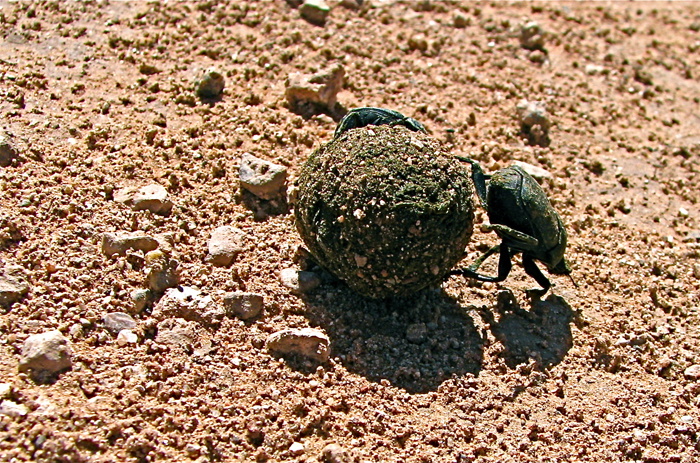
Right now, I empathize. But remember, the lowly dung beetle is a type of Scarab. It’s said that to the ancient Egyptians the scarab and its dung ball symbolized the sun god Ra rolling the solar disc across the sky each day, transforming bodies and souls the way the dung beetle turns manure into the next generation. So keep it rolling, right? (Photo E.Shock, Cochise Co, AZ)
…. where the hell everyone’s been since last september.
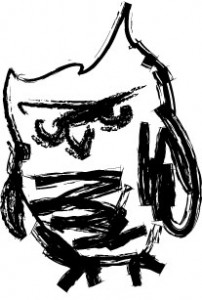
While a longer post about Gulf Fritillaries is in progress, please enjoy these images of Rosy-faced Lovebirds (formerly Peach-faced Lovebirds, Agapornis roseicollis) feeding on our sunflowers one gray morning earlier this month.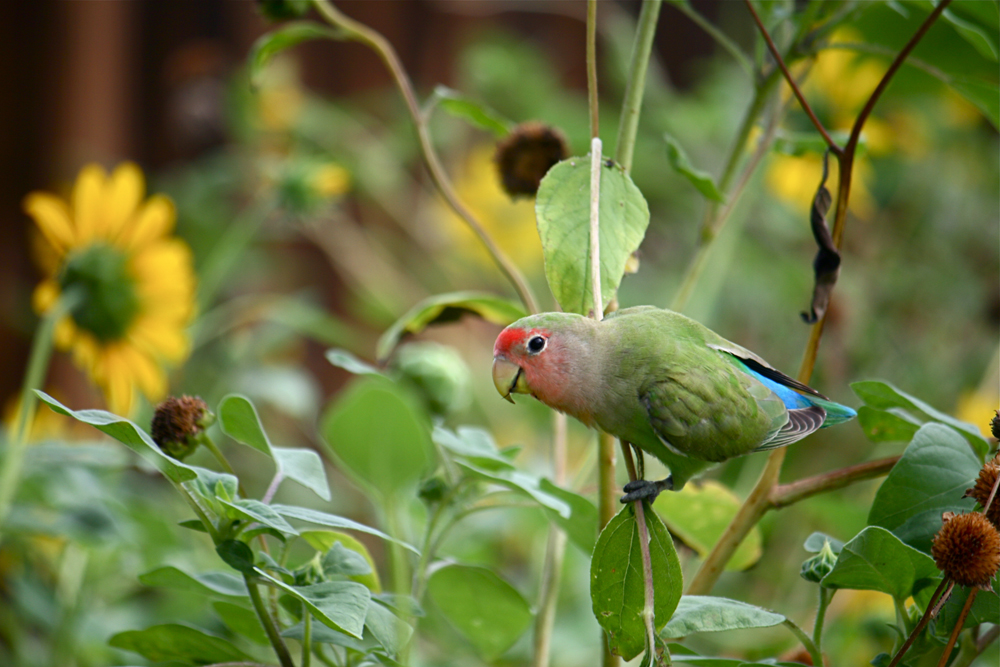
Rosy-faced Lovebird cling-feeding on sunflowers (photos A.Shock)
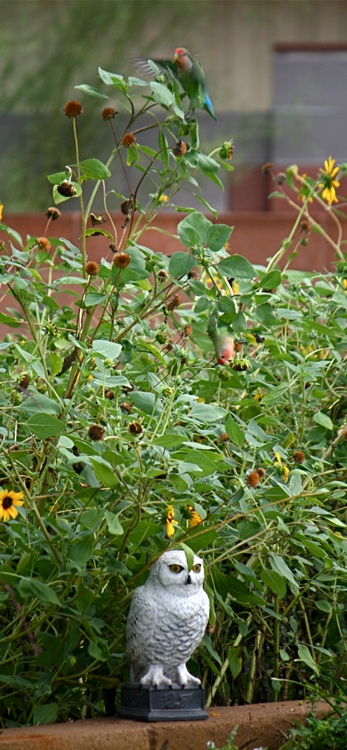 Having learned the older name, E and I still refer to them as Peach People (or more portentiously “People of the Peach”), and rush out to try to spot them overhead each time they bomb across the yard, squeaking and gibbering in small family groups.
Having learned the older name, E and I still refer to them as Peach People (or more portentiously “People of the Peach”), and rush out to try to spot them overhead each time they bomb across the yard, squeaking and gibbering in small family groups.
Accustomed to their dry homeland in southwestern Africa, Lovebirds are a non-native feral species which seems to be establishing itself in apparently self-sustaining populations around the Phoenix area. They are the descendants of escaped or released pet birds — often let go by people because of their noisy domestic ways. Lovebirds are often found in and around Saguaros, where they compete with resident cavity-nesters like Elf owls and woodpeckers for the shelter of snug holes in the giant cactus.
Also, please note the previously discussed effectiveness of plastic birds of prey as seed-snatcher deterrents in the garden >> Actually, it’s an empty complaint — we grow the sunflowers for the birds, and would be crushed if the Desert Snowy Owl and the Birthday Falcon (still sheathed in plastic to mute its awesome aspect) actually worked.
Actually, hopefully not.
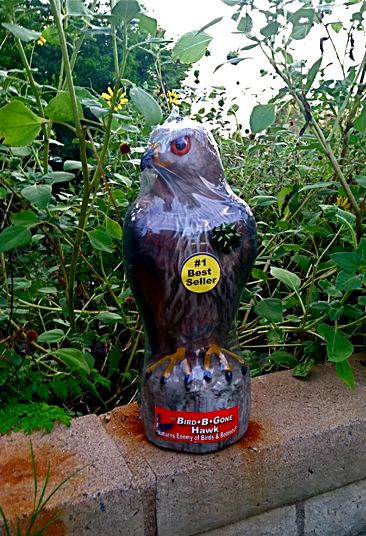 Here is the much anticipated Birthday Falcon still in its protective cello wrap with best-seller badge and restrainedly celebratory gift ribbon. I just retrieved it home after a visit with Kate, who presented it to me. It has “good feathery detail,” although it’s something of a chimera, with the head of a bald eagle, the large staring eyes of a kite, the breast and feet of a peregrine falcon, and (not pictured) the bricky red tail of a Red-tailed hawk. The theory, I guess, is to cover all possible bases of scaring: Finches flinch at everything, and doves are too dumb to decoy, but if you’ve got trout, cicadas, swallows, and any good-sized ground dweller like rabbits or snakes plaguing your land, this guy has got all your pest-scaring problems in hand.
Here is the much anticipated Birthday Falcon still in its protective cello wrap with best-seller badge and restrainedly celebratory gift ribbon. I just retrieved it home after a visit with Kate, who presented it to me. It has “good feathery detail,” although it’s something of a chimera, with the head of a bald eagle, the large staring eyes of a kite, the breast and feet of a peregrine falcon, and (not pictured) the bricky red tail of a Red-tailed hawk. The theory, I guess, is to cover all possible bases of scaring: Finches flinch at everything, and doves are too dumb to decoy, but if you’ve got trout, cicadas, swallows, and any good-sized ground dweller like rabbits or snakes plaguing your land, this guy has got all your pest-scaring problems in hand.
So the Birthday Falcon now resides next to a plastic snowy owl (that known ferocious non-scourge of all desert birds) on a low block wall between our herb garden and the patio section of the All-You-Can-Eat Fink Bar, an unruly tangle of sunflowers beloved by Lesser Goldfinch (the authentic locals) and also Rosy-faced Lovebird tourists, purely for asthetic and entertainment value. At least, that’s the hope. Kate has reported her version of this winged terror to be actually terrifying to her yard birds which, of course, we agree is totally unacceptable.
So tomorrow we’ll watch: if there’s any disturbance in the furious fressing of finches at the flowerheads, we’ll have to relocate the feathery menace to a less effective location, and enjoy it there. Possibly the living room.
Our fence had some extra height this morning, and a glorious tail. Do you see the fur anomaly? I’m pretty sure it sees you.
It was obliging, and let itself be fully revealed. Such a kitty-dog! That’s a 6-foot wall it leaped upon with little effort. They regularly use the block walls in the neighborhood like geometric trails, navigating nimbly with neat-nailed feet, safely above the jaws of coyotes and the hubbub of dogs.
So — finally! — photos of the neighborhood Gray fox (Urocyon cinereoargenteus). E was in the right place at the right time, or the fox was, depending on your viewpoint.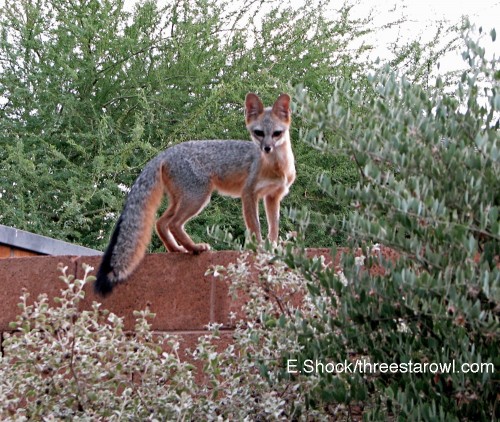
Here’s another shot. LOOK AT THAT TAIL!!!!!
The tail is key — here’s a bit reposted from an earlier post on our gray foxes:
Etymology
Foxes are canids, but not Canis, the genus of dogs, wolves, coyotes, and jackals. The Gray fox has its own genus: Urocyon, which is from Greek ὀυρά, tail, and κύων, dog. Its species is cinereoargenteus, from Latin cinis, ash, plus L. argenteus, of silver. Put them together, and its name means “silvery ashy-black dog-tail“. In case you’re wondering, the genus of the Red fox  and other “true foxes” is Latin Vulpes, meaning “fox”, which does NOT give us our word “fox.” That is said to be derived through Old English from Old German fukh (the modern German word for fox is fuchs), derived from the Proto-Indo-European root puk- which means “tail.”
and other “true foxes” is Latin Vulpes, meaning “fox”, which does NOT give us our word “fox.” That is said to be derived through Old English from Old German fukh (the modern German word for fox is fuchs), derived from the Proto-Indo-European root puk- which means “tail.”








